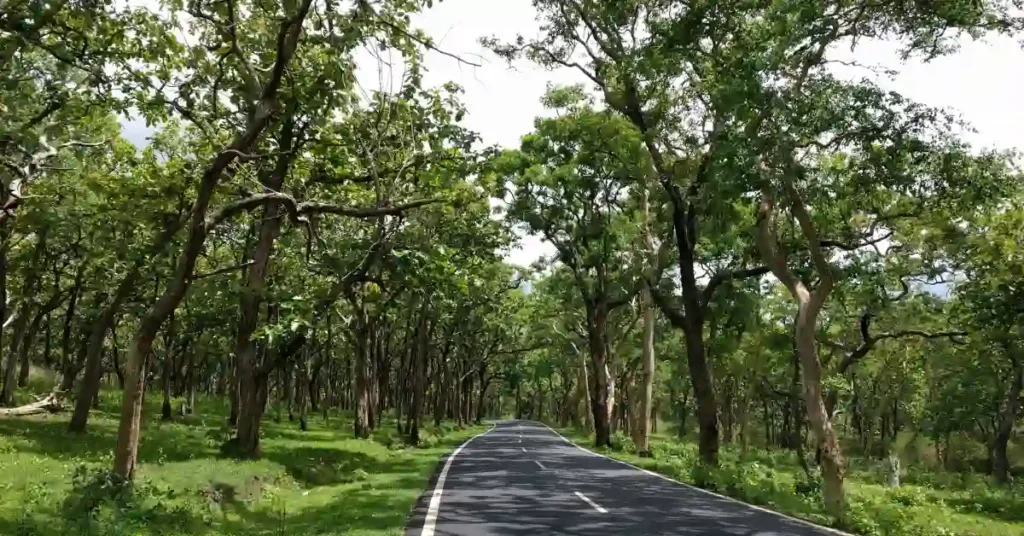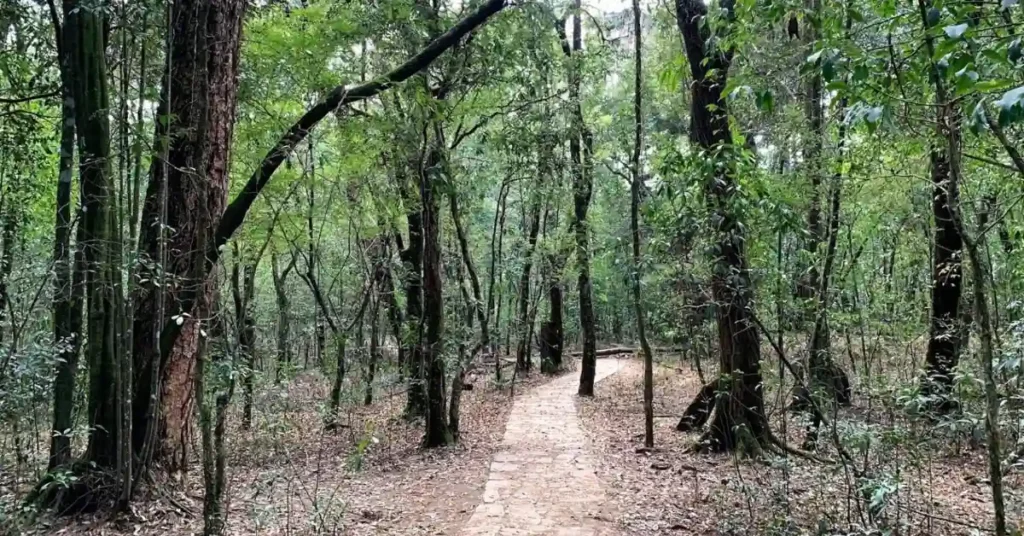Introduction
Imagine towering trees reaching for the sky, dappled sunlight filtering through emerald leaves, and the symphony of nature filling the air. This isn’t a dream; it’s the reality of India’s diverse and magnificent forests.
This article embarks on a journey through eight beautiful forests in India, inviting you to discover their hidden gems. Whether you’re an ardent wildlife enthusiast, a nature lover seeking serenity, or simply curious about the incredible ecological tapestry of this vast land, each forest promises an unforgettable experience.
So, lace up your boots, pack your sense of adventure, and prepare to be enthralled by the verdant wonders that await!
Read Also: Top 10 Most Dangerous Snakes in the World
Sundarbans National Park, West Bengal

This UNESCO World Heritage Site, established in 1984, is the largest mangrove forest globally, encompassing an area of 10,000 sq km (core area of the Sundarbans Tiger Reserve: 1,330 sq km), straddling India and Bangladesh.
Sundarban is the home to the majestic Royal Bengal Tiger, it teems with diverse flora and fauna, including unique saltwater crocodiles and various bird species.
Beyond the rich wildlife, Sundarbans boasts a unique landscape sculpted by the ebb and flow of the Ganges, Brahmaputra, and Meghna rivers. The intricate network of waterways, mudflats, and dense mangrove forests creates a dynamic and ever-changing environment. You can explore this wonderland on a boat safari, navigating narrow channels and soaking in the otherworldly beauty.
- Interesting Fact: The Sundarbans is the only mangrove forest harboring tigers, with an estimated population of around 101 (According to IndianExpress).
Planning your trip? 🚘
For more details and booking information, please visit the Sundarban National Park official website: www.sunderbans-national-park.com
Jim Corbett National Park, Uttarakhand

Jim Corbett National Park, nestled in the foothills of the Himalayas, roars with the title of India’s oldest and most prestigious national park. Established in 1936, it’s a haven for wildlife enthusiasts and nature lovers alike. This park boasts the highest tiger population among its Indian counterparts, making it a prime spot for thrilling safaris.
But the magic doesn’t stop there. From majestic elephants and elusive leopards to playful otters and almost 600 species of birds (according to the official site), the diverse wildlife here will leave you breathless. Lush forests, rolling grasslands, and marshy depressions paint a vibrant landscape, offering a unique backdrop for your exploration.
Planning your trip? 🚘
For more details and booking information, please visit the Jim Corbett National Park official website: www.corbettnationalpark.in
Bandipur National Park, Karnataka

Located in the Nilgiri Hills, this diverse park encompasses dry deciduous forests, grasslands, and shola forests. It holds the distinction of having the highest density of herbivores in Asia.
Tigers reign supreme in Bandipur, with one of the highest densities in India. Glimpse these majestic predators during exhilarating jeep safaris, or keep your eyes peeled for the elusive Indian elephant, the graceful leopard, and the lumbering gaur. Don’t miss the playful antics of langurs swinging through the trees, the watchful gaze of the sloth bear, and the vibrant calls of over 200 bird species.
- Interesting Fact: Bandipur National Park was the first tiger reserve in India to successfully implement the relocation of human settlements, minimizing human-animal conflict.
Plan Your Perfect Adventure!
Explore all you need to know for an unforgettable journey to Bandipur National Park on the official website: www.bandipurnationalpark.in
Mawphlang Sacred Forest, Meghalaya

Nestled amidst the Khasi Hills, this unique grove is managed by the local Khasi community and holds immense cultural significance. Lush greenery, towering trees, and ancient megaliths create a mystical atmosphere.
For the Khasi people, the Mawphlang Sacred Forest is not just a natural wonder, but a living embodiment of their spiritual beliefs. They believe the forest to be inhabited by spirits, particularly the powerful deity Labasa, who watches over their village and protects them from harm. Sacred rituals are performed within the forest’s boundaries, seeking blessings for good harvests, health, and prosperity.
You can witness the reverence with which the locals approach this sacred space, adding another layer to the forest’s captivating allure.
- Interesting Fact: The Mawphlang Sacred Forest follows a strict conservation practice of “living root bridges,” utilizing the aerial roots of banyan trees to create sturdy, living bridges over streams.
Your Travel Planner: Tripadvisor
Gir National Park, Gujarat

This sanctuary is the last refuge of the majestic Asiatic lion, with over 600 individuals thriving within its protected boundaries. Dry deciduous forests, grasslands, and seasonal rivers dominate the landscape, offering glimpses of other mammals like leopards, jackals, and various bird species.
Nestled in Gujarat, India, Gir National Park roars with the title of the last remaining abode of the majestic Asiatic lion. Established in 1965, this 1,412 sq. km haven is a vibrant tapestry of dry deciduous forests, rugged hills, and serene water bodies. Its diverse ecosystem shelters not just the iconic lions, but a treasure trove of other wildlife.
Imagine embarking on a jeep safari, anticipation thrumming through the air as you scan the landscape for a glimpse of a majestic lion’s mane emerging from the tall grass. But the park’s magic extends beyond these regal predators. Keep your eyes peeled for the elusive leopard, the graceful blackbuck, golden jackals, and the lumbering gaur, all sharing this verdant stage.
- Interesting Fact: Once on the brink of extinction, the Asiatic lion population in Gir National Park has witnessed a remarkable comeback, thanks to dedicated conservation efforts.
Discover everything you need to plan your thrilling adventure at Gir National Park by visiting the official website: www.girnationalpark.in
Namdapha National Park, Arunachal Pradesh

Flanked by the Himalayas in the north and the Patkai Hills in the south, Namdapha National Park sprawls across northeastern India’s Arunachal Pradesh, cloaked in an aura of untamed wilderness. Established in 1983, this 1,985 sq. km haven holds the distinction of being India’s largest and most biodiverse national park.
But the park’s magic lies not just in its landscapes. It’s a wildlife wonderland teeming with over 1,400 faunal species. The elusive snow leopard prowls the high altitudes, while the majestic tiger reigns supreme in the lower regions. Keep your eyes peeled for the playful gibbons, the graceful elephants, and the shy clouded leopard, all sharing this verdant tapestry. Over 500 bird species fill the air with their melodies, from the vibrant hornbill to the elusive black-backed forktail.
- Interesting Fact: Namdapha National Park boasts the highest diversity of mammals in India, with over 400 recorded species, making it a haven for wildlife enthusiasts.
Pichavaram Mangrove Forest, Tamil Nadu

Pichavaram Mangrove Forest, nestled near Chidambaram in Tamil Nadu, India, isn’t just a forest; it’s a labyrinthine world woven from saltwater magic. Spread across 1478 hectares (According to tnswa.org), often called the “second-largest mangrove forest in the world”, a unique ecosystem where land and sea intertwine in a mesmerizing dance. Imagine a vast expanse of water dotted with verdant islands, their roots submerged in the brackish embrace, creating a maze of waterways teeming with life.
Pichavaram’s magic lies in its biodiversity. Spot playful otters frolicking in the water, graceful dolphins slicing through the waves, and majestic kingfishers perched on branches, their vibrant colors contrasting the emerald foliage. The air hums with the calls of around 177 bird species (According to Wikipedia), while the forest floor is a haven for crabs, mudskippers, and diverse insects. But the star attraction is undoubtedly the mangrove itself, a complex ecosystem that filters water protects the coastline, and provides nursery grounds for countless fish and marine life.
- Interesting Fact: Pichavaram Mangrove Forest plays a crucial role in coastal protection, acting as a natural barrier against cyclones and tsunamis.
Plan Your Trip: Tripadvisor
Dzukou Valley, Nagaland

Nestled amidst the majestic Naga Hills on the border of Nagaland and Manipur in India, Dzukou Valley unfolds like a dreamland painted in vibrant hues. Its name, meaning “cold water” in the Angami Naga dialect, aptly reflects the refreshing streams that meander through the valley, while the alternative Mao Naga term “dziikou” translates to “dreamlike,” perfectly capturing the valley’s ethereal charm.
Dzukou Valley’s beauty transcends seasons. During spring, the valley explodes in a kaleidoscope of colors, with wildflowers like lilies, rhododendrons, and orchids carpeting the rolling hillsides. The air hums with the melody of birdsong, while butterflies flit amongst the vibrant blooms, creating a scene straight out of a fairytale.
- Interesting Fact: Dzukou Valley is said to be inhabited by the elusive Dzü, a mythical wild beast, adding to its mystical charm.
Plan Your Trip: Tripadvisor
Conclusion
India’s forests are more than just trees. They’re vibrant ecosystems, cultural treasures, and sanctuaries for endangered species. Each one leaves a mark, reminding us of our connection to nature and our responsibility to protect it. So, the next time you crave fresh air or a connection with the wild, remember these diverse forests. Choose your adventure, step into their verdant embrace, and let the magic unfold.




